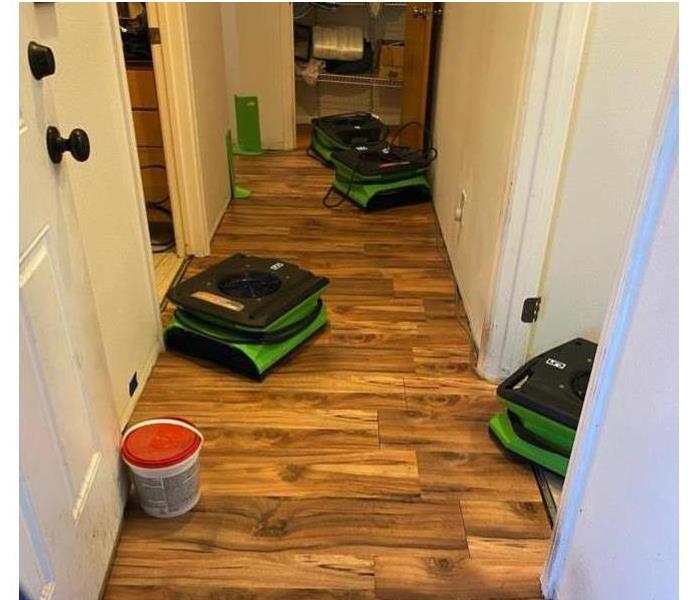What Tools Do Professionals Use for Water Removal?
3/1/2022 (Permalink)
When Water Disasters Impact Your Beaumont/Banning Home, We Have Multiple Strategies to Remove Standing Water and Begin the Drying Process
Removing water from surface materials in your Beaumont/Banning home requires several tools and technologies in our growing inventory of recovery equipment. After a thorough inspection of your property following a disaster, we can identify the most appropriate mitigation and restoration plan for your specific structure. Ultimately, we make these decisions based on the most efficient path to returning your home or business to its original condition.
The tools and technologies that promote water restoration for homes and businesses can vary significantly from one property to the next. As a leading restoration company for the Beaumont/Banning area, we have a broad assortment of extractors and water removal tools to address both standing water and trapped moisture in porous materials like wood flooring and carpets.
What Are the Best Tools to Remove Surface Water?
Standing water can be one of the most destructive effects left behind after a water damage incident. Without quick action, absorption can occur to exposed materials. The removal of standing water is an essential effort to prevent unnecessary tear-out and reconstruction of areas that could otherwise be preserved. Some of the best types of tools for this action include:
- Pumps – Electric submersible pumps and other units like high-pressure extractors and self-priming trash pumps are vital in different conditions to remove surface water. The effectiveness of these extractors hinges on the depth of the water involved. Under two inches of standing water causes the pumps to lose prime and become less effective.
- Vacuums – Vacuums are a versatile water removal tool in our arsenal because of their portability. In addition to these units' mobility, wet vacuums are even more useful when combined with various wands and attachments for specific extraction scenarios.
- Wands – Special attachments for vacuums in submersible pumps can help resolve specific issues encountered in removing water. Wands are exceptionally beneficial for areas where accessibility is an issue.
Is Trapped Water Challenging to Remove from Carpeting?
Thousands of homes have carpeted floors, though the type of material used can vary from one residence to the next. With the likelihood of carpeted floors encountering water damage after a loss incident, our SERVPRO team must prepare for these circumstances. We have multiple tools designed to address these immediate concerns through water removal and drying practices. When approached quickly enough, it is often possible to protect and preserve the carpeting layer, even if the padding underneath must get replaced. Some of the mechanisms that we utilize to recover saturated carpeting include:
- Light Wands
- Carpet Wands
- Weighted Extractors
- Floating Carpets
Is Trapped Water Destructive to Wood Flooring?
With multiple types of wood flooring, the effect of standing water and absorption on this building material can vary. Our response to these conditions determines the likelihood of preserving these installed materials and reducing the need for tear-out and reconstruction. Often, there are three types of water damage in wood plank flooring. These include surface water, free water, and bound water. The various water penetration states dictate how and if wood flooring can get dried and restored or if controlled demolition is a more cost-efficient approach. There are multiple tools used in the recovery of wood flooring, including:
- Floor Drying Mats
- Tenting
- Dehumidifiers
- Air Movers
When Is a Material Too Damaged to Preserve?
Water exposure can have an undeniable impact on specific sensitive materials like drywall. After only 24 hours of exposure, direct contact of water with installed drywall material promotes swelling, sagging, and collapse. It is the prerogative of responding technicians to evaluate these risks and begin implementing controlled demolition practices whenever necessary to protect the house and the team's occupants. When a material is considered too damaged to leave installed, we can quickly uninstall it and discard the sheetrock to reduce relative humidity and moisture content in the house, leading to mold growth, further water damage, and other concerns.
It is not always cut and dry what your property needs after a water disaster, but extraction and water removal are often involved in some capacity. Understanding what measures must get taken to return a house to the preloss condition involves the data collected during the initial inspection and evaluation of the property by our project manager. You can count on our SERVPRO of Beaumont/Banning team for our fast response with these efficient extraction tools to make water damages "Like it never even happened." We are available 24/7 at 951.922.2900.





 24/7 Emergency Service
24/7 Emergency Service
